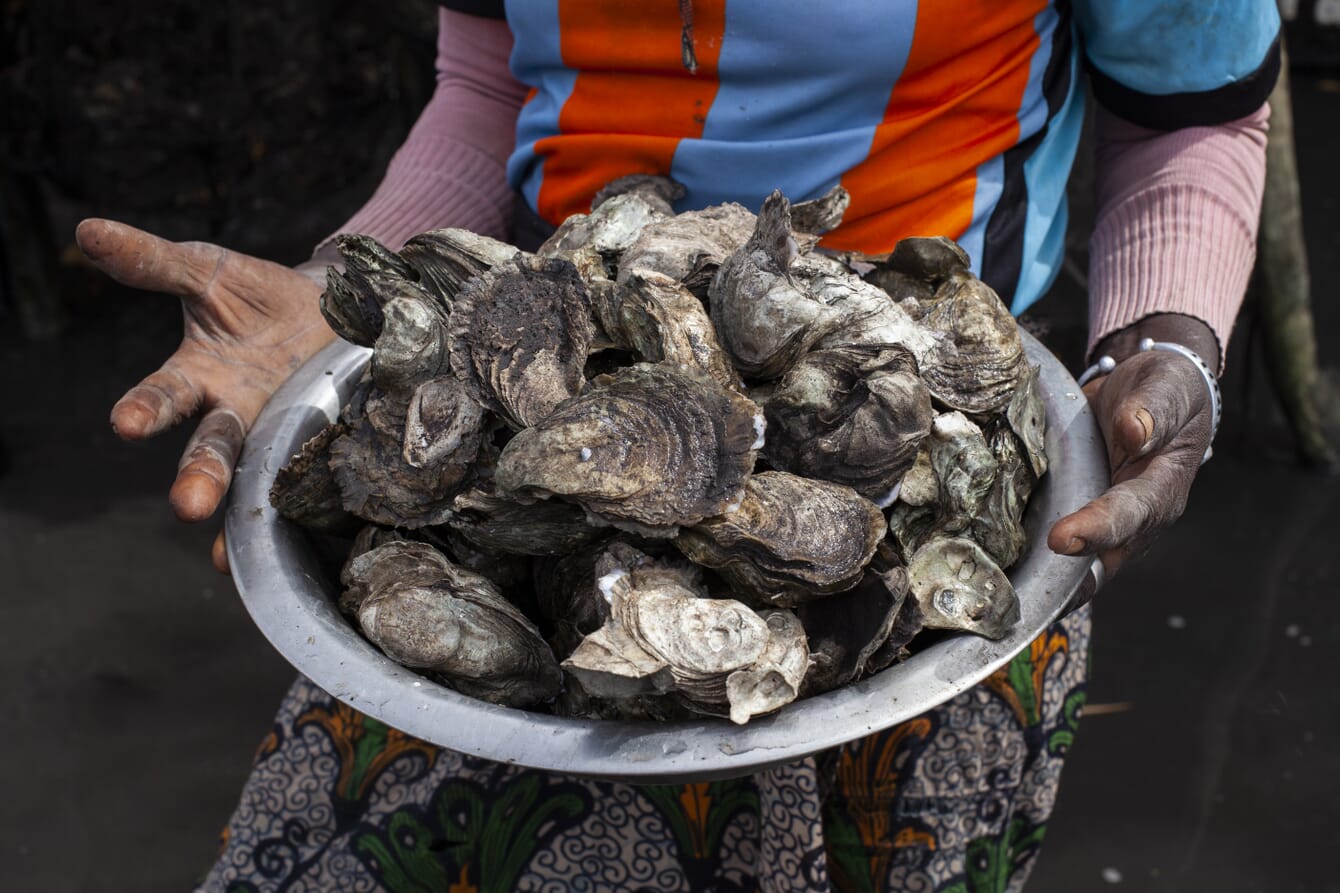
FISH4ACP's work in Senegal focuses on enhancing the productivity and competitiveness of its oyster value chain, making sure that economic improvements go hand-in-hand with environmental sustainability and social inclusiveness. © FAO/Marta Moreiras
Can you tell me a bit about the Fish4ACP initiative?
FISH4ACP is an initiative of the Organisation of African, Caribbean and Pacific States (OACPS) aimed at making fisheries and aquaculture value chains more sustainable and is implemented by FAO with funding from the European Union (EU) and the German Federal Ministry for Economic Cooperation and Development (BMZ).
In this new initiative FISH4ACP aims to enhance the productivity and competitiveness of the fisheries and aquaculture value chains in twelve OACPS member countries, making sure that economic improvements go hand-in-hand with environmental sustainability and social inclusiveness. It will pay special attention to small- and medium-sized businesses, because of their potential to deliver economic and social benefits, particularly for women and youth.
Why did you decide to investigate Senegal’s oyster value chain?
Given its socio-economic and environmental importance, as well as its potential for inclusive development, the oyster value chain was proposed by the government and competitively selected from over 75 proposals from countries across the African, Caribbean and Pacific regions.
What were the main findings relating to:
Production levels and techniques?
Following our very thorough value chain analysis (VCA) we found out that production levels were much higher than what was estimated initially. Original figures said 400 tonnes, but the actual number is estimated to be around 16,000 tonnes, of which only 400 tonnes come from farming. Given that wild harvest is so predominant and that oyster production techniques are still quite rudimentary, FISH4ACP plans to provide capacity building and investment support to allow the VC stakeholders to migrate towards oyster farming.
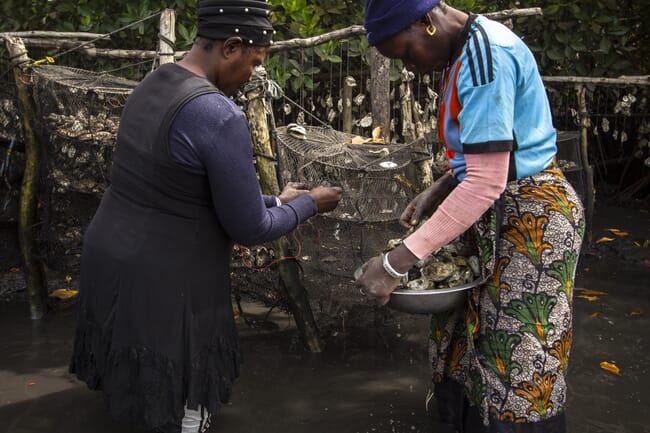
Fish4ACP conducted a value chain analysis of Senegal's oyster sector and found that domestic demand has outstripped the country's oyster supply. © FAO/Marta Moreiras
The market for domestically produced oysters?
The VCA also shed light on the fact that national demand is mostly for processed oysters, and it is not yet met by national supply, which leads to the importation of large informal and unquantified quantities from neighbouring countries – Gambia, Guinea Bissau, Guinea and Sierra Leone. The market for fresh oysters, mainly comprising tourists, received a big hit during the Covid-19 pandemic, but is slowly recovering.
Which of the results were you most surprised about and why?
Our estimations show that only 84 percent of the national demand is met by domestic production. This is one of the most surprising results and will have to be confirmed by a more statistically sound analysis. However, if it is, then this is an opportunity for the value chain, which also has implications in terms of food security.
What proportion of Senegal’s oysters are farmed and what proportion are wild-caught and are there many differences between the two in terms of quality, profitability etc?
Only 2.5 percent of total production comes from oyster farming, with only two established farms and some artisanal oyster farming initiatives. The oysters that are being farmed are triploid Pacific oysters (Crassostrea gigas), imported from France. Given the high water temperatures in Senegal these grow three times faster than in Europe and reach market size in less than a year.
The native species is Crassostrea gasar, which is found in the mangrove trees and wild harvested. Once processed (either dried or smoked) there is no difference in the taste of the product. However, there is a very big difference in profitability between processed and fresh oysters, with the latter being sold to tourists at a much higher price (0.13 USD/kg for processed oysters, compared to 7 USD/kg for fresh).
Is there conflict between the farmers and harvesters?
There is no conflict between the oyster farmers and the local community of women harvesters, and in fact, FISH4ACP contributed to creating a link between one of the farmers and a community in Nema Ba, who are now working together to increase the wild capture of the local Gasar species to be on-grown at the farm. Cups for the capture of oyster spat are being placed in different locations in the Saloum estuary, the women collect them and the oyster farmer collects them at regular intervals to then grow them in his farm in the Somone lagoon.
If the pilot is successful, this could mean that importing oyster spat from France would no longer be needed and it would significantly reduce the risk of importing pathogens and exotic species from Europe.
On a more general level, FISH4ACP is actively working towards associating all value chain stakeholders by creating a multi-stakeholder partnership named “National network of actors in the oyster value chain in Senegal” (Réseau National des acteurs de la chaîne de Valeur des huîtres - RENACVAH), which is expected to strengthen the value chain.
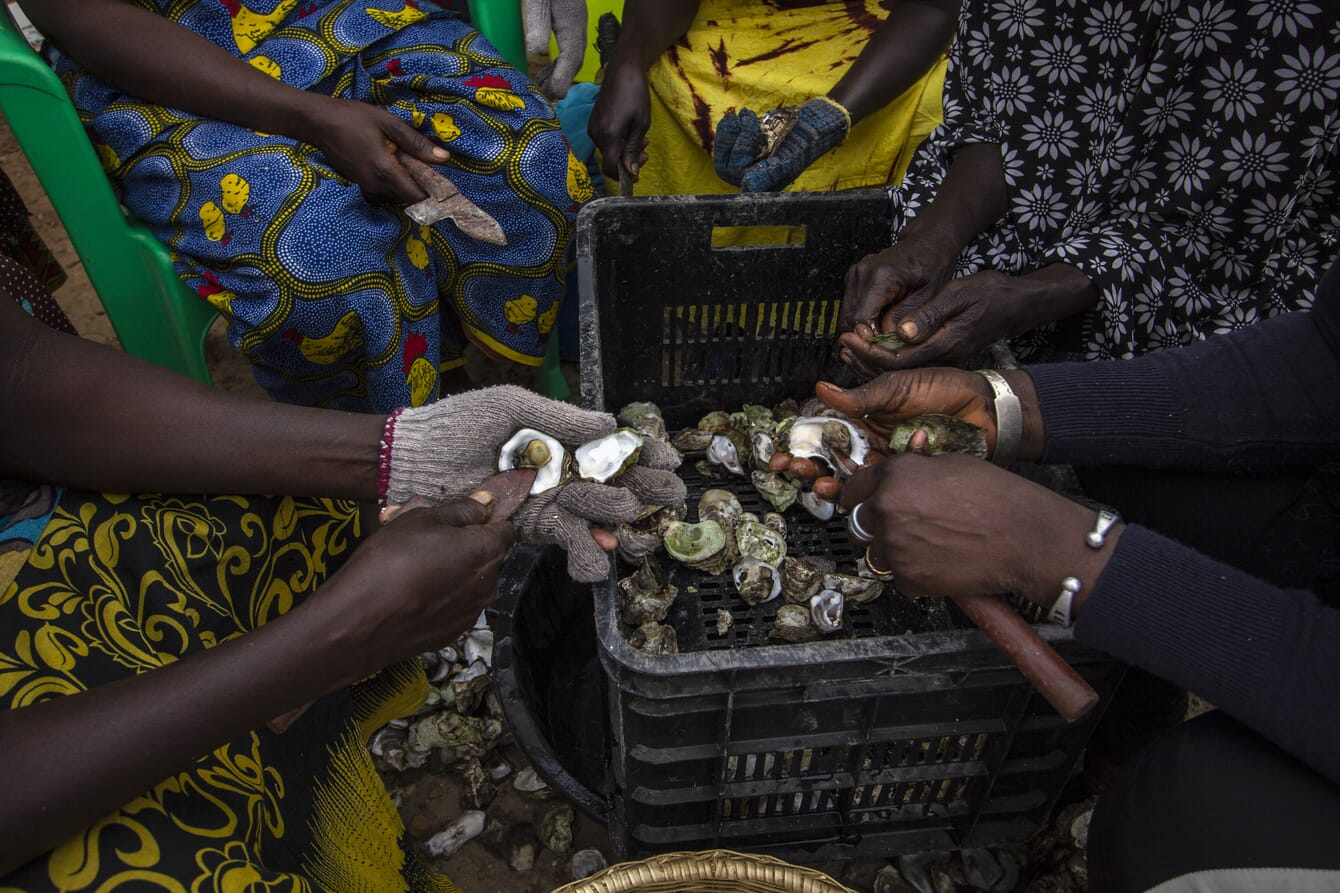
Only 2.5 percent of Senegal's total oyster production comes from farming, with only two established farms and some artisanal oyster farming initiatives. © FAO/Marta Moreiras
Which part of the sector has the most growth potential?
There is great potential in migrating towards oyster farming, but this needs to go hand-in-hand with a thorough scientific assessment of the most favourable areas for aquaculture and with clearer rules for land tenure.
What are the main challenges the farmed oyster sector needs to overcome before it can improve its output?
Apart from the two challenges listed above – namely the lack of scientific studies and clear rules on land tenure – I would say that the farmed oyster sector needs to work with the Senegalese government to establish an effective food safety surveillance framework. The regulatory framework, the respect of sanitary standards and the infrastructures and equipment necessary to respect these standards must be improved, to allow for a safe and sustainable development of the value chain.
What would your advice be to anyone looking to join the oyster sector in Senegal?
This is a sector with great potential and my main advice would be to look at the domestic market for the equipment needed instead of resorting to imports from Europe. This would improve the sustainability of the value chain overall and would produce a ripple effect in terms of economic benefits.
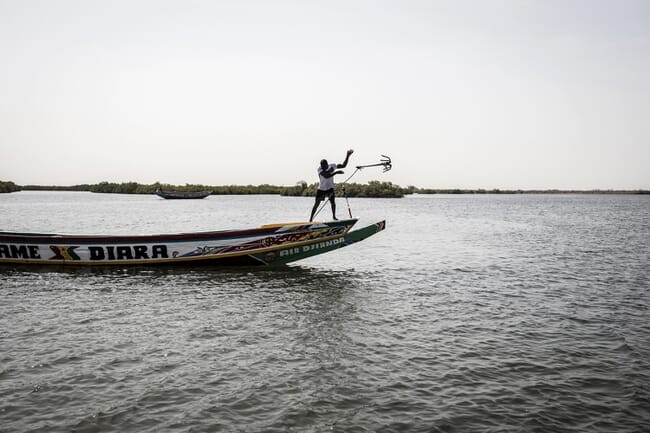
Historically, Senegal has been fisheries oriented, but it is beginning to embark on aquaculture ventures. © FAO/John Wessels
What are the weakest/strongest links in the chain?
I would say that processing and marketing capacity could be improved. On the one hand, to improve the shelf life of processed oysters and, on the other, to ensure access to larger markets for fresh ones. The presence of professional services (such as labs for testing and national experts and researchers specialised in the production and transformation of oysters) is a strength.
Are there any oyster farming techniques or pieces of equipment that you think are particularly suitable for the local conditions?
This is exactly what we would like to find out. We have recently launched a call for offers for a scientific study that will set up 25 pilot sites nation-wide to test different techniques and equipment. We are excited to kick-start activities and we hope to be able to share the results in 2024.
Do you think the country has potential to farm other aquatic species?
Absolutely. Aquaculture is growing in Senegal and the dedicated agency (Agence Nationale de l’Aquaculture – ANA), which is one of our partners in the implementation of the project, is doing an excellent job through its extension services.
Why has the country been so slow to develop its aquaculture sector?
Senegal is historically a fisheries country. The fisheries sector contributes 3.2 percent to Senegal’s gross domestic product, and accounts for 10.2 percent of Senegal’s exports. However, depletion of stocks and a steep rise in demographic growth call for alternatives, including an increase in aquaculture. Senegal's Emergent Strategic Plan (Plan Sénégal Emergent - PSE) will likely contribute to boosting the sector with its declared aim of producing 50,000 tonnes of aquaculture products by 2025. Aquaculture development is a process that involves the establishment of favourable conditions for farms, a sound legal framework, incentives and a highly committed private sector. I can say that Senegal is on the right track.
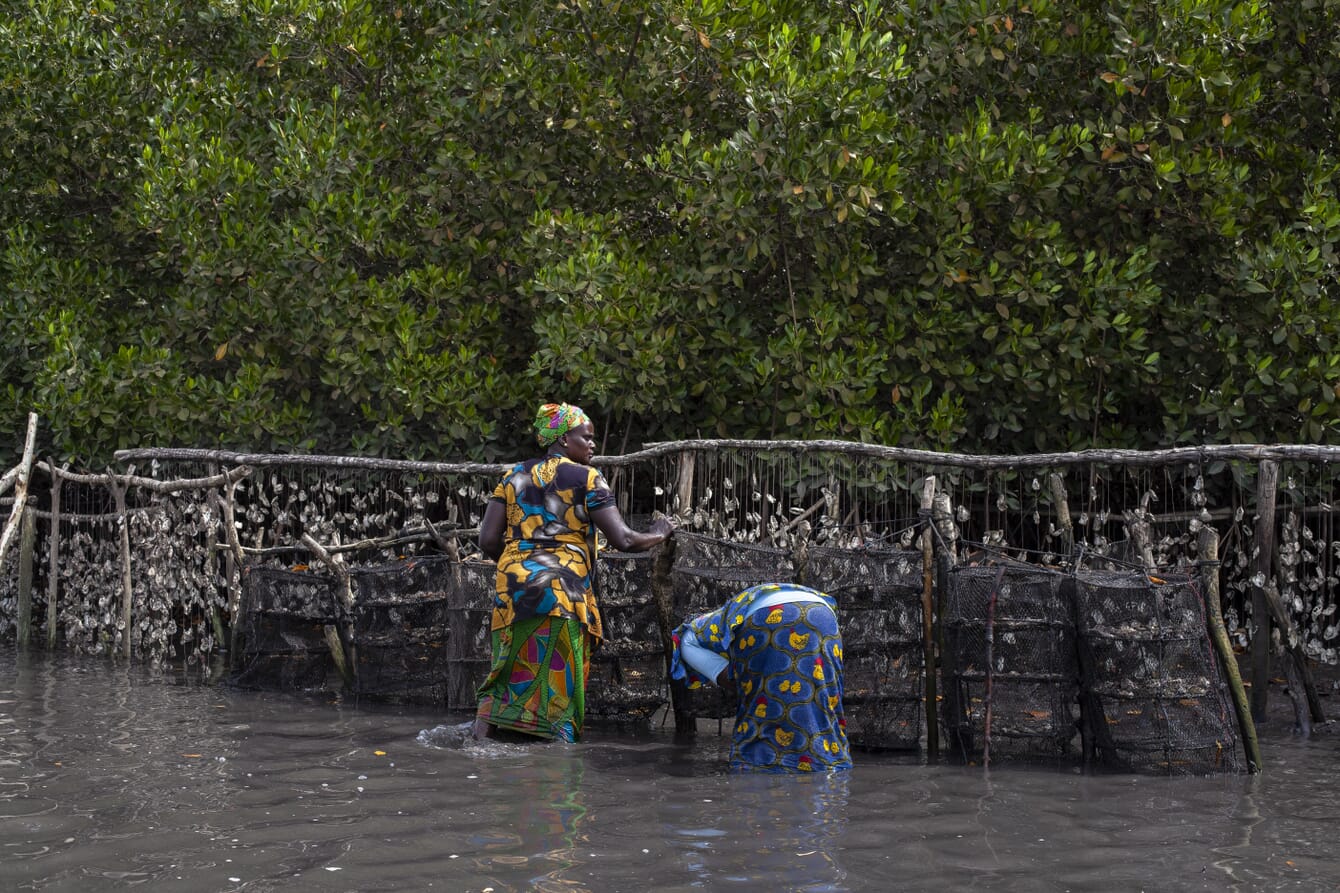
Fish4ACP's value chain analysis suggests that prospective oyster farmers should source their equipment from domestic suppliers to improve the sustainability of the value chain overall. © FAO/Marta Moreiras
Are there any individuals or organisations who you’d like to give a special mention for their role in the development of Senegal’s oyster sector?
I would like to commend the Direction des Industries de Transformation de la pêche (DITP), which is the main partner of FISH4ACP in Senegal and acts as government focal point. Also the ANA and Le Fonds National de Développement Agro-Sylvo-Pastoral (FNDASP) for their hard work in improving the governance of the sector and creating the right conditions for the development of the value chain.
It is also very important to mention the young entrepreneurs with a strong motivation to develop the sector. A strong involvement of the private sector is paramount to developing a value chain and all stakeholders must commit to bring change. And of course, the EU, BMZ and OACPS, without whom none of this would be possible.
How do you plan to follow up on the findings of the report?
Based on the findings of the report, the FISH4ACP team – in consultation with all relevant stakeholders – has developed an upgrading strategy to make Senegal’s oyster value chain more productive and sustainable, with a view to transforming it as a catalyst for economic and social development.

Fish4ACP expects that by 2032, nearly 25 percent of Senegal’s oyster production will come from farms – a five-fold increase in ten years. © FAO/Marta Moreiras
FISH4ACP is supporting an ambitious agenda to improve local production, provide better jobs and ease the burden on the environment. Much of this growth will come from oyster farming, in part because of environmental advantages that enable better protection of mangroves and more responsible management of stocks.
By 2032, nearly 25 percent of Senegal’s oyster production is set to come from farms – a five-fold increase in ten years. Growth will also lead to better jobs. The number of full-time jobs is expected to almost double, while higher value and longer shelf-life products are set to push up the value-added sector to be worth over $12 million in ten years, leading to increased revenues for Senegal’s female oyster producers.




